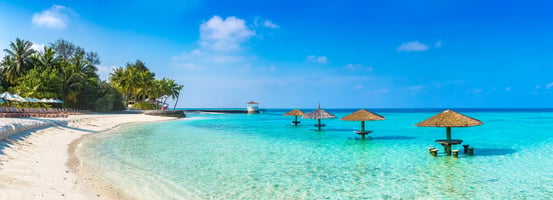Tourism contributes a disproportionately large share of economic activity across many Caribbean...
Destination Marketing Strategies Across North America
In total, in North America, there are 23 officially recognized independent states. The largest of them is Canada, followed by the also rather big United States. These two giants together occupy more than 79% of the whole continent's area. The smallest country in this part of the world is Saint Kitts and Nevis, which occupies only two small islands in the Caribbean.
Tourism is a powerful economic driver across the continent, though dependence varies dramatically. Aruba leads North America with 43.39% of its GDP coming from tourism, thriving on luxury beach resorts, cruise tourism, and honeymooners. Other highly dependent countries include:
- Antigua & Barbuda – ~29.5% of GDP
- Bahamas – ~10.1% of GDP
By sheer total revenue, however, the top three countries are the largest:
1. USA – $2.36 trillion
2. Mexico – $30–40 billion
3. Canada – $25–30 billion
These markets are trending strongly for high-end escapes in 2025:
- Aspen, Colorado – Ski-in/ski-out lodges, champagne lounges
- Vancouver Island, BC – Coastal retreats like Wickaninnish Inn
- New York City – Michelin-starred dining, Broadway, Fifth Ave shopping
- Napa Valley, CA – Vineyard estates, private tastings
- Los Cabos, Mexico – Oceanfront villas, private chefs
Luxury travelers in 2025 are chasing exclusivity, nature immersion, and bespoke experiences. For weddings, the most in-demand destinations include:
- Whistler, BC – Gondola-accessed mountaintop venues
- Jackson Hole, WY – Rustic elegance with Grand Teton views
- Riviera Maya, Mexico – Beach weddings near Mayan ruins
- Newport, RI – Cliffside mansions and oceanfront gardens
- Aspen, CO – Snowy romance or autumn foliage ceremonies
As destination growth marketers we sell a moment, a mindset, and an economic engine. Over the past decade the “how” of destination marketing has diverged across North America: Canada leans into slow, regenerative wilderness narratives; the United States leverages scale, pop culture and segmentation; Mexico fuses beach with world-class culinary and heritage storytelling; and the Caribbean, small by land area but enormous in tourism dependency and diversity, competes on paradise while rapidly reinventing its product and distribution models.
High-level positioning
-
Canada: “Get away to decompress. Vast wilderness, Indigenous-led authenticity, slow and regenerative travel.”
-
United States: “Anything you want, anywhere you want it. Cultural diversity, events, and scalable experiences.”
-
Mexico: “Color, food, culture. Accessible warmth between history and resort luxury.”
-
Caribbean: “The world’s easiest escape. Sun, sea, music — but increasingly specialized and product-diverse.”
Strategy, Focus and Style
Canada
-
Strategy: Target higher-spend segments (nature-lovers, adventure-luxury, slow cultural experiences). Emphasize dispersal (move visitors beyond a handful of hotspots) and regenerative tourism.
-
Focus Areas: National parks, Northern experiences (Aurora), Indigenous tourism partnerships, wellness and nature retreats.
-
Creative Style: Cinematic, reflective, authenticity-first; campaigns foreground people and place. Emotional storytelling over flashy stunts.
United States
-
Strategy: Hyper-segmentation by state/city and strong integration with events, entertainment, and commerce. Big budgets for data-driven digital and experiential campaigns.
-
Focus Areas: Urban experiences, live events and festivals, road trips, culinary and sports tourism.
-
Creative Style: Bold, punchy, often pop-culture-forward. Performance-first digital buys and influencer partnerships are core.
Mexico
-
Strategy: Maintain strong volume from traditional sun-and-beach segments while lifting lesser-known regions via gastronomy, cultural events, and boutique/regenerative stays. Address safety perception proactively.
-
Focus Areas: Coastal resorts, UNESCO heritage, gastronomy (destination chefs), festival tourism.
-
Creative Style: Vibrant, sensory-led, culturally rooted, a celebration of color, food and music.
Caribbean
-
Strategy: Many islands rely on tourism as a primary GDP driver; marketing balances volume-driven campaigns (especially all-inclusive & cruise feeder markets) with growing niche segments: luxury, adventure, culture and wellness. Regional coordination complements national branding.
-
Focus Areas: Stayover vs cruise strategies, all-inclusive and resort experiences, diving/sailing, festivals and music tourism, sustainability and resilience.
-
Creative Style: Lush, escapist visuals; messaging often centers on emotional relief and sensory cues (warmth, rhythm, relaxation), but increasingly includes authenticity and environmental stewardship.
Go-to marketing channels and tactics by region
-
Canada: High-production video (YouTube/OTT), PR tied to experiences, partnerships with outfitters and Indigenous-led tour operators, high-touch niche trade.
-
U.S.: Programmatic display and social, influencer and celebrity tie-ins, events sponsorship, major OTA partnerships for scale.
-
Mexico: Integrated TV + digital for feeder markets, influencer + culinary partnerships, travel trade for resort packages.
-
Caribbean: Heavy reliance on U.S. and EU feeder markets, paid search and metasearch for direct-booking capture, cruise line partnerships for port marketing, OTAs for package distribution, and trade shows for MICE and travel trade.
What are your thoughts on the comparative destination marketing strategy and style across Canada, the U.S., Mexico and the Caribbean?
-2.png?width=512&height=512&name=KC%20GROWTH%20PARTNERS%20(1)-2.png)

.png?height=200&name=Untitled%20design%20(5).png)
